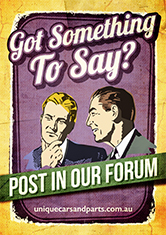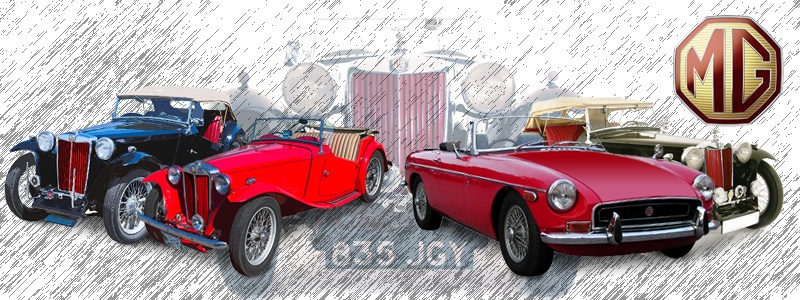Introduction
The MG Marque is one of the best known in the motoring world, and has been for more than 80 years. And yet there is a great deal of confusion and contradiction over the history of MG. There has been some difference of opinion about when the first MG was built - and even more confusion about when the last one will be built. In 1979 British Leyland announced that production of MGs was to be discontinued so that the MG factory at Abingdon could be used to make components for other BL cars, and later be used to build the new BL-Honda car.
William Morris was always interested in mechanical things. Around the turn of the century he began repairing bicycles and later motorbikes. In 1911 he began to sell various makes of cars and in 1913 began to build his own Morris cars. The premises in Oxford from which the cars were sold was known as The Morris Garage, and later when additional premises were bought the business became The Morris Garages. By 1923 William Morris was so deeply involved in designing his latest car that he appointed as manager of Morris Garages the man who had joined the company as sales manager the previous year, Cecil Kimber.
In the Twenties it was quite common for rich young men to have specially-bodied cars built for themselves on production chassis and in 1923 Kimber arranged to have six Raworth two-seater bodies bought in and fitted on Morris Cowley chassis. It is probable that these two-seaters were called MGs — after Morris Garages — although another special, built in 1925 for competition use was for a long time regarded as the first MG, and is today preserved and known as "Old Number One". Rebodied Morrises were now being sold as MGs and were eagerly snapped up by enthusiastic drivers, so great was the demand that the old premises at Morris Garages were not large enough. A factory at Abingdon in Berkshire was bought and in 1929 the MG Car Company moved into the premises which it has occupied ever since.
Record Breaking MG’s
During the 1930’s MGs had a great deal of competition success and set some speed records which were remarkable in their day. On 16th February 1931, George Eyston drove a car of less than 750 cc to a speed in excess of 100 mph (161 km/h) for the first time when he drove an MG Midget at an average of 166.04 km/h over five kilometres at the Montlhery track in France. Later in the year - October 17th - he raised the record to 177.55 km/h and in February 1932, with a streamlined body fitted, the car was measured at 190.59 km/h at Pendine Sands.
At the end of the Thirties, on 31st May 1939 - only three months before Britain declared war on Germany - there was apparently little hostility between the motoring enthusiasts of the two countries because a speed attempt in a specially built streamlined 1100 cc six-cylinder MG (based on the Magnette racing car) was made on a closed section of German autobahn near Dessau. Actually two records were set. The first, for under 1100cc supercharged engines, was done with the standard MG capacity of 1086 cc and the car covered the flying kilometre first in one direction then in the other at an average speed of 327.69 km/h - incredible! Not happy with just one record the driver, Major "Goldie" Gardner, had the engine capacity increased from 1086 cc to 1106 cc the very next day and so put it into the 1100 to 1500 cc category He then raised the average speed to 328.89 km/h. And all this on a public highway!
MG’s In Racing
In their early days MGs were very popular with ordinary drivers who used them in car club competitions. But MGs also took part in some top line racing in the Thirties - and enjoyed a great deal of success. Take for example the career of the first Magnette racing sports car. This car was designed and built in a rush to compete in the 1933 Mille Miglie road race and travelled to Italy in the hold of a storm-tossed ship. Although the brand-new car could not by rights even be expected to finish the tough 1600-kilometre race, George Eyston drove it to victory in its class and shattered the 1100 cc class records.
A few months later the same car was driven by one of the women racing drivers of the period, Mrs T.H. Wisdom, in the International Trophy on the giant speed bowl at Brook-lands. At speeds of up to 175 km/h the little car finished in third place against much larger competitors. After several more successful races the Magnette was put out to grass and was used as a hack by the MG team mechanics, mainly running around to pick up parts for later racing machines. Then not long before the Ulster Tourist Trophy race was due to begin, Eyston heard that Tazio Nuvolari - regarded by many people even today as the greatest racing driver of all time - was looking for a car for the race. So Magnette "Number One" was hastily prepared and Nuvolari, who had never driven a Magnette and had never used a preselector j gearbox (as was fitted in the Magnette) in a race, won easily after breaking the lap record an amazing 11 times. The car was timed at 185 km/h on the straight - not bad for an 1100 cc car almost 50 years ago!
Post-war: TC to MGB
The "Square Rigged" TC is probably the most famous MG of them all. Introduced in October 1945, it was a logical development of the TA and TB which were first built in 1936 and 1939 respectively. The TC was virtually the same as the TB except that the body and track were widened to make more space in the cockpit which now became merely cramped - instead of very cramped as previously! The TC set new production records for MGs - some 10,000 were built.
The TB and TC used a modified Morris 10 engine of 1250 cc capacity, unlike the TA which had a Wolseley power plant (The Wolseley company by that time was also owned by William Morris). The TC was the first MG to be sold with optional left-hand-drive for the American market and enjoyed instant success in that country. Four years later, in 1949, the MG TD was released. It retained the same engine as the TC in a similar-looking, but less strikingly-styled, body and on a completely new chassis. It had independent front suspension and steel wheels in place of the former's wire-spoke wheels.
The TF, introduced in 1953, was an updated TD using a lower and sleeker body which still looked a lot like the earlier cars. The TF was available with either steel disc or wire-spoke wheels (the latter were fitted to all of the cars sold in Australia). In 1954, the TF's engine was enlarged to 1466 cc. Shock and horror from traditional MG enthusiasts greeted the totally new styling of the MGA when it was released in 1955! The separate front wings and running boards, which had been fitted to every MG since their introduction 30 years previously, had gone. And the striking big radiator grille had been squeezed into a barely recognisable horizontal shape and blended into the front of the car. A new engine, which retained the same capacity of 1500 cc, was fitted to the A and virtually the whole mechanical set up was different.
In 1958, a 1588 cc twin overhead-cam engine was offered as an option but it proved troublesome and was withdrawn in 1960. The twin-cam MGA also featured four-wheel disc brakes. A conventional 1588 cc overhead valve engine, which was an enlargement of the 1500 cc unit, was fitted and this engine increased in size to 1622 cc with the introduction of the MGA Mk II in 1961. The MGB, which was much the same as the car being built today, was launched 18 years ago in 1962. It was based on the MGA except that a monocoque body instead of a separate chassis was used and the engine was again increased in size - to 1798 cc.
Three years later, in 1965, the standard open car was joined by an MGB GT which had a closed body with a small hatchback rear end. The MGB Mk II released in 1967 offered an optional automatic transmission for the first time and the standard manual gearbox was given synchromesh on first gear. The two most famous variations of the MGB were the MGC and MGB GT V8. The MGC was sold between 1967 to 1969 and used a six-cylinder 3.0-litre engine in basically the same body - a power bulge in the bonnet to accommodate the big engine is the most noticeable difference. This heavy engine caused strong understeer and was soon given up.
The MGB GT V8 was sold between 1973 and 1976. This car used the 3.5-litre Rover V8 engine which gave it tremendous acceleration while maintaining reasonable handling. From 1974 onwards the MGB had an unusually-styled, black urethane bumper to comply with American regulations. At the same time the whole body was raised 35 mm to increase the height of the bumper above ground level. This was a cheap way of doing the job from BMC's point of view but spoiled the handling of the B. Later modifications improved matters.
Late Model Midgets
The TF was the last of the old-style MG Midgets and the name was not used again until 1961 when MG badges were stuck onto what was really an Austin-Healey Sprite. These cars had a 950cc engine which was increased in capacity to 1100 cc the following year. A Mk 2 Midget was released in 1964 and a Mk 3, with a 1275cc engine was brought out in 1966. A Triumph engine of 1500cc, borrowed from the Spitfire, was installed in 1975. The Midgets were a little cramped inside and difficult to get into or out of, but were great fun to drive and always seemed to be going much quicker than they really were, so you could get the thrill of speed - without the speeding fines.
Buying A Used MG
A second-hand MG of any type (and there are MG sedans as well as the sports two-seaters) is not a used car - it is a valuable collector's item. That is why you have come to the Unique Cars and Parts web site. And that is why you are still reading this article. Provided you service and maintain a MG, it should remain in good condition indefinitely, whereas a normal car is only required to last for perhaps 10 or 15 years. So unless you are prepared to spend vast amounts of money on restoration try and get a car which has a body in reasonably good condition.
Early MG'swill almost certainly fall into two categories - restored to new - or even better than new condition, or in very bad order. The latter will probably be lying around gathering dust and dry rot in its timber frame while its owner gathers the initiative and the cash to proceed with the restoration. If you buy a restored car you will pay big money for it so it should be virtually faultless. If you are checking one in poor condition make sure there is not too much rust or rot in the body. Try to get a car which is as complete as possible, forfinding replacement parts can be a problem.
Problem Areas
MGB, MGC: Rust can be a real problem on early models so look carefully at the sill panels, the rear mudguards, the rear edges of the front guards as well as in front of the windscreen and in the floor of the cockpit. If the car has been driven hard then synchromesh on all gears, especially 2nd, may be worn - check by making quick up and down changes (cars before 1967 do not have synchro on first gear). If the clutch shows signs of slipping due to hard use, it means expensive repairs are necessary because the engine must be removed to replace it. Cylinder-head gaskets can be a problem area so have a compression test carried out on the engine. Engine tappet noise is quite common and not usually a problem unless bad.
MIDGET: Check for rust in the floor, the door bottoms, sill panels and in the front and rear mudguards. Look for general wear and looseness in the suspension as this is a common fault after hard use. Check the gearbox and clutch for smooth, quiet operation.
Collector Notes: The
MG story is well-known and covered in detail in our feature articles on the marque. It is enough to list the models. A few
TCs arrived in Australia in 1947 but 1948 saw a growing number and a long waiting list. The
TC stayed in production until the TD appeared in
1950, ending the era of 19-inch wheels and beam front axles. The TD Series II (
1952) continued until
1954 when the TF with the lights in the front guards and a snug cockpit took over. The TF received a 1.5 engine transplant in
1955 and was replaced in
1956 with the MGA, the first of the "modern" MGs. The "A" came in the 1500 series (
1956 -
1960), 1600 series (
1960 to
1962) and 1600 Mk II (
1962 to
1963). The MGB followed in
1963 with an 1800 engine; major changes followed in
1965 and
1968. Local production ceased in November
1972. The MG Midget, with a 1275cm3 engine, ran from
1967 to
1972. The TC is probably the top MG as a collector's item but the TF is the best of the early ones if you want a car to drive regularly. Since the demise of MG as a manufacturer, MGBs have been appreciating strongly.
Also see: MG
History |
The MG Story 



